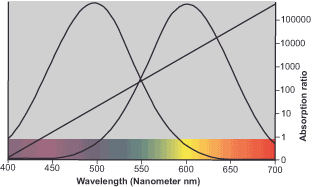You are here: Nature Science Photography – Lightness and color – The perception of lightness and color
The question remains to be answered: why do we perceive colors, and what is the evolutionary meaning of color vision? Scientifically, this is still very controversial. A frequently represented explanatory approach assumes that color is a sensation that enables us to distinguish between two structureless surfaces of the same brightness. Such surfaces are called isoluminant. It should be critically noted that a) we very rarely encounter surfaces with such purely spectral differences in the wild, and b) distinguishing them is a really difficult task for the visual system (17). Therefore, the majority of researchers currently do not believe that this method effectively addresses the core issue.
This is most likely true for another property of the objects around us. In figure 25 (Colorful leaves and flowers SW) the single flowers differ from each other or from the surrounding grass only by the brightness values. These are partly close to each other, and therefore it is difficult to distinguish the individual objects from each other at a quick glance. In figure 26 (Colorful leaves and flowers color), which contains the color information in addition to the brightness values, this is different. Here, the previously laborious differentiation succeeds with ease. Since our ability to survive for the longest time of our development depended on our ability to quickly distinguish friend from foe, good food from bad food, we may conclude that our ability to differentiate individual wavelength ranges (on which our color vision is based) primarily serves the rapid and efficient object recognition and segmentation of a visual scene (18). Moreover, we find this preference reflected in the properties of the where- and what-channels: the what-channel is divided into a shape-system, which uses brightness and color information to recognize object shapes, and a color-system, which describes surface colors. The shape-channel has the highest resolution of all subsystems, while the color-channel has the lowest, and since color is used only for object classification, this makes perfect sense.


With just one type of cone receptor, we can only classify visual impressions on the basis of their brightness. With two different types of receptor, however, we are able to distinguish visual impressions on the basis of their brightness and spectral composition. Compared to the normal spectrum, however, a certain area would be missing in each case. Without the L-cones or M-cones, the long-wave red and the medium-wave green-yellow areas would be missing. Without the S-cones, we would have to do without the short-wave violet-blue part. Only with two receptors that are as ideally coordinated as those shown in figure 27 would we be able to perceive the spectrum that our three S, M and L cones provide us with today. In this case, every wavelength mixture would be encoded by a clear activity ratio of the two receptors. – The diagonal proves this actual unambiguousness for every point within the visible spectrum.

The fact that we need three types of cones today to cover the range between 380 nm and 700 nm shows that evolution works well but not perfectly. The first mammals were quite small and lived inconspicuously among the giant dinosaurs before primeval times. As warm-blooded animals, they had a decisive advantage over the ectothermic lizards: they could also be active at dusk and at night since they were not dependent on the warming sun. They colonized this ecological niche and only switched to a diurnal way of life about 65 million years ago. However, during their twilight lives, their color vision atrophied because they simply did not need it. As a result, most mammals living on Earth today have only two cone types with different sensitivities: a S-cone and an M-cone. Because of this, they are called dichromats. Among mammals, only the primates of the Old World (Eurasia and Africa), from which modern humans have evolved, and some of the South American New World monkeys have evolved into trichromats in the course of evolution. In the Old World monkeys, the M-cone gene duplicated and underwent slight changes, resulting in the genome containing not only information for the blue pigment but also for a red-sensitive and a green-sensitive visual pigment. Thus the three cone types with their different absorption maxima developed. Independently, a trichromatic system also evolved in some New World monkeys. However, only the howler monkey has color vision comparable to that of the Old World monkeys. In other New World monkeys, however, only the females are trichromats, since a red-green gene is located in various forms on the X-chromosome. However, since only females have two X-chromosomes, only they can possess the information for two different visual pigments and thus distinguish red from green. Males, on the other hand, are always red-green blind. This development may have been caused by the following factors: Monkeys that are able to distinguish red from green can more easily find ripe, red fruit in green foliage and more safely distinguish young, easily digestible leaves, from older, tougher ones because these nutrient-rich leaves have a slight red coloration. These are significant advantages, so tetrachromasia likely caught on quickly. Most reptiles and birds, unlike mammals, did not go through a nocturnal phase. Thus, they were able to continuously develop their color abilities and became true color vision experts over the past millions of years. Today, we find numerous tetrachromats, who, thanks to four different receptor types, possess a much finer color discrimination ability than humans.
In summary, we can state that color is correctly defined as a sensation that allows us to easily distinguish objects from each other that are difficult to distinguish due to their brightness distribution. Color perception, then, is not an end in itself and did not evolve to make the world more beautiful for us. Nevertheless, we do not know and may never know why we perceive a visual stimulus of 530 nm wavelength as green and one of 670 nm as red.
Next The technical generation and description of brightness and color impressions
Main Lightness and Color
Previous Red is better than blue – Our preference for warm colors
If you found this post useful and want to support the continuation of my writing without intrusive advertising, please consider supporting. Your assistance goes towards helping make the content on this website even better. If you’d like to make a one-time ‘tip’ and buy me a coffee, I have a Ko-Fi page. Your support means a lot. Thank you!


 Since I started my first website in the year 2000, I’ve written and published ten books in the German language about photographing the amazing natural wonders of the American West, the details of our visual perception and its photography-related counterparts, and tried to shed some light on the immaterial concepts of quantum and chaos. Now all this material becomes freely accessible on this dedicated English website. I hope many of you find answers and inspiration there. My books are on
Since I started my first website in the year 2000, I’ve written and published ten books in the German language about photographing the amazing natural wonders of the American West, the details of our visual perception and its photography-related counterparts, and tried to shed some light on the immaterial concepts of quantum and chaos. Now all this material becomes freely accessible on this dedicated English website. I hope many of you find answers and inspiration there. My books are on